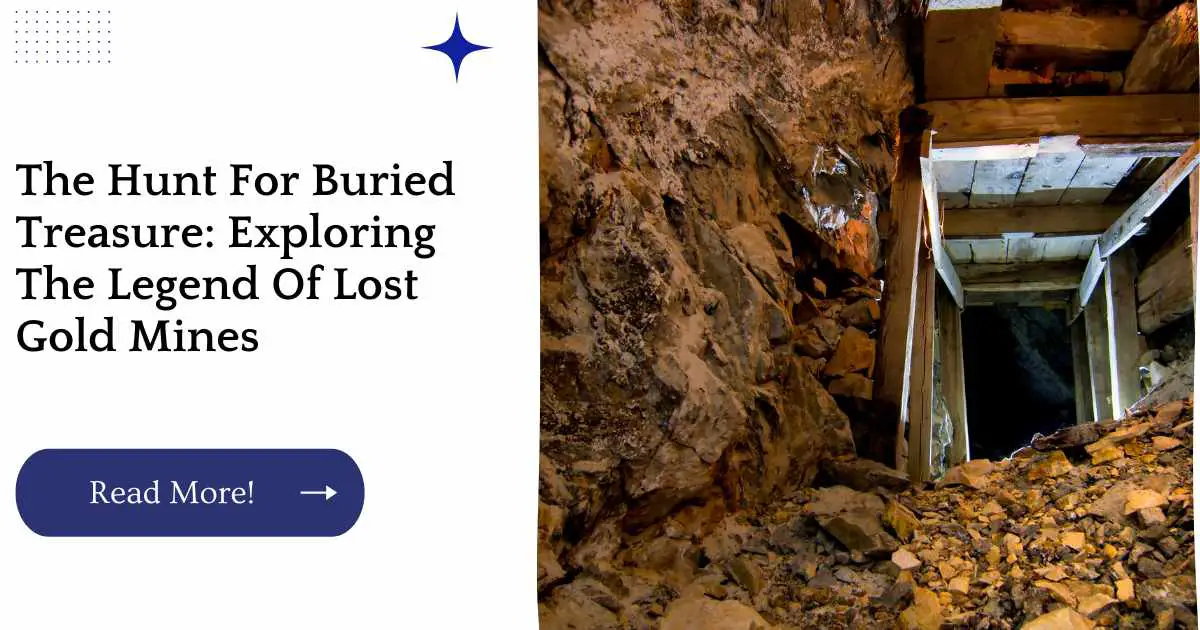The legend of buried treasure is nothing new. Tales of lost gold mines and forgotten fortunes date back to the dawn of humanity.
Even today, adventurers are still searching for hidden riches in ancient Spanish mines and other places and some of them even find it! If you’re interested in hunting down your own fortune, here’s how to go about it:
| Key Points |
|---|
| Lost mines and treasure hunting have fascinated people for centuries. |
| The search for lost gold mines is a challenging and exciting adventure that requires skill, knowledge, and perseverance. |
| There are many famous lost mines from around the world, including the Lost Dutchman’s Gold Mine, the Treasure of the Sierra Madre, and the Oak Island Money Pit. |
| To be successful in treasure hunting, you need to be well-equipped, well-informed, and have a passion for adventure. |
| While the existence of many lost mines remains a mystery, the stories and legends behind them continue to capture the imagination of treasure hunters and adventurers today. |
Talk To Everyone.
Don’t be afraid to ask for help. The old adage “it takes a village,” is as true today as ever. You never know who might have information that will lead you to your treasure. Ask around and you may be surprised by how many people are willing to assist in your search.
Don’t forget the locals! They will likely know where the best places are to look, and they may even be willing to show you where they found their gold mine while on an expedition of their own!
If all else fails, try asking other explorers who have been searching for buried treasure before you! Many times they will be happy share their knowledge with others looking for treasure so that everyone can reap the benefits of each other’s discoveries.
“Discovering abandoned gold mines is not just an exciting adventure, it can also uncover fascinating stories of America’s past. Learn more about the secrets hidden in abandoned mines with our guide on uncovering the secrets of abandoned gold mines.”
Explore Every Possibility
The first step in your search is to take a look at all of the possibilities. The legend of gold mines has been around for centuries, and this means that there are many different locations where you can start your search.
Some people believe that the legendary Lost Dutchman Mine is just one of many in the Superstition Mountains, while others are convinced that there are multiple lost Spanish mines hidden in southeastern Arizona.
If you decide to go out on your own, keep this in mind as you research each location: don’t get stuck on one theory!
If you’d rather not explore these sites yourself or if they’re inaccessible by foot or helicopter (or whatever other mode of transportation), then look into other options like old maps and records from various groups who explored the area over time.
You might also want to use aerial photographs taken over time; they could help pinpoint areas that were once gold-rich but have since been covered up with new vegetation so that it doesn’t stand out as much anymore just remember not everyone will agree about which photographs should be used!
Look At Aerial Photographs
Buried treasure hunters should look at aerial photographs. These are pictures of the land taken from above, such as Google Earth or Bing Maps. You can find them on the internet and at local historical societies.
Aerial photos are a great tool for finding lost mines because they show you what’s under the surface of the ground. They’re also more detailed than maps, so you can see things like old roads that may have been used by miners to get to their claim sites.
“The search for lost gold mines has been a part of American history for centuries, and the stories behind these quests are truly captivating. Take a journey through time with our guide on the quest for lost gold mines and discover the legends, myths, and realities of the American West.”
Follow Clues And Trails
Use historical documents to your advantage. Look at old maps and charts, newspapers, letters, diaries and photographs. If you’re lucky enough to have access to the internet or a library that allows you to look through their archives then check out those resources as well.
Pay attention when examining these types of documents because they can help lead you directly to historical sites that may hold lost treasure. For example: if there was an item written about a certain location in the newspaper at an earlier time then this is probably where people went after they found it!
Look Where Others Have Looked
When you’re searching for a lost gold mine, it’s important to know where other people have looked and how they went about their search. If you’ve never heard of the place you’re looking into, chances are good that it’s been searched before and all the information has been filed away somewhere.
If your research leads you to a particular location but there is no documentation of anyone having found anything there, it might still be worth checking out the previous researchers may have missed something or not fully explored an area because of time constraints or other reasons.
It’s always better to take a second look at where others have looked than wander aimlessly without direction!
Be Patient, Nothing Will Happen Overnight.
While searching for a lost gold mine can be exciting, it’s important to keep in mind that finding the treasure won’t happen overnight.
If you get discouraged and think something is happening too slowly, take a step back and try to look at the bigger picture. If you’re patient, nothing will happen overnight: there will be plenty of time for exciting discoveries later on!
“El Dorado, the legendary city of gold, has fascinated treasure hunters for centuries. If you want to learn more about the search for lost gold mines in America, check out our guide on the search for El Dorado. You’ll discover the stories and myths behind one of the most elusive treasures in history.”
Seek Out Local Experts
In many cases, you’ll find that the most helpful people are those who actually live in or around the area you’re interested in exploring.
If you know someone who lives near a particular mining area and has lived there for more than a few years, ask them about local legends and stories regarding lost gold mines. They may be able to point out areas that have been searched before (and why) and also help guide your search from there.
In addition to asking other locals for advice on where to begin your search, talk with people who work at or run businesses in these areas as well.
For example: if you want to look around an old ghost town out west but don’t know anyone else personally who lives nearby, look into working at a campground nearby instead!
These campgrounds often employ park rangers whose job includes helping travelers find things like hiking trails or scenic points of interest near their campsites and they’ll likely be able to point out possible locations where buried treasure could lie beneath the surface too!
“The search for abandoned gold mines in the wilderness is a challenging and exciting adventure that requires skill, knowledge, and perseverance. If you’re up for the challenge, check out our guide on lost in the wilderness: the search for abandoned gold mines in the USA. You’ll find tips, tricks, and stories from experienced treasure hunters to help you on your journey.”
Conclusion
Buried treasure is a lot of fun to think about, but it’s also important to remember that you should never take the idea too seriously.
If you’re looking for buried gold yourself, remember that there are plenty of resources available online and in person that can help you get started on your journey.
It might take some time before anything happens or maybe nothing will at all but don’t let these setbacks stop you from pursuing this exciting hobby!
Further Reading
For more information on lost mines and treasure hunting, check out the following resources:
Lost Dutchman’s Gold Mine on Wikipedia: Learn about the legends and stories behind one of the most famous lost mines in American history, the Lost Dutchman’s Gold Mine.
List of Lost Mines on Wikipedia: Discover a comprehensive list of lost mines from around the world, including the stories and legends behind them.
Explore the Dutchman on AZ State Parks: Visit the official website of Lost Dutchman State Park to learn more about the history, legends, and natural beauty of the Superstition Mountains.
FAQs
What is the Lost Dutchman’s Gold Mine?
The Lost Dutchman’s Gold Mine is a legendary mine located somewhere in the Superstition Mountains of Arizona. According to legend, it was discovered by a German immigrant named Jacob Waltz, also known as the Dutchman, in the 19th century.
Is the Lost Dutchman’s Gold Mine real?
The existence of the Lost Dutchman’s Gold Mine has never been proven, and its location remains a mystery to this day. However, many people continue to search for the mine, and the legend has become a part of American folklore.
“The great American gold rush was a defining moment in American history, and the treasures discovered during this period are still being sought after today. If you’re interested in learning more about the search for lost mines and treasure, check out our guide on the great American gold rush: searching for lost mines and treasure. You’ll discover the stories, legends, and treasures that still capture the imagination of treasure hunters and adventurers today.”
What are some other famous lost mines?
There are many famous lost mines from around the world, including the Treasure of the Sierra Madre, the Oak Island Money Pit, and the Lost Rhoades Gold Mines.
What should I bring on a treasure hunting expedition?
It depends on the type of treasure hunting you plan to do. However, some useful items to bring include a metal detector, a map and compass, a GPS device, a first aid kit, and appropriate clothing and footwear.
Is treasure hunting legal?
In most cases, treasure hunting is legal as long as it is done on public land or with the permission of the landowner. However, there are laws and regulations that govern the excavation and removal of archaeological artifacts and other historic objects.

Hi there! My name is Hellen James, and I’m here to talk to you about treasure hunting. I’ve been a fan of treasure hunting ever since I was a kid, and if you’re a fan of treasure hunting or just like the idea of finding a long-lost fortune, then this blog is for you.

